Enhancing Sustainable Disaster Risk Management: Landslide Susceptibility Evaluation Using AdaBoost-CB Ensemble and Multi-Dimensional Vegetation Metrics in Yuanling County, China
Abstract
1. Introduction
- (1)
- To quantify the individual and combined contributions of multi-dimensional vegetation metrics to landslide-susceptibility modelling;
- (2)
- To compare the predictive performance of the proposed AdaBoost-CB ensemble with five widely used ML algorithms;
- (3)
- To produce a scientifically robust landslide-susceptibility map for Yuanling County, Hunan Province—a representative vegetated mountainous region in subtropical China.
2. Study Area and Data
2.1. Study Area
2.2. Data
2.2.1. Landslide and Non-Landslide Data Preparation
2.2.2. Environmental Factor Preparation
Vegetation Factors
Topographic Factors
Climatic and Hydrological Factors
Geological Factors
Human Activity Factors
3. Methodology
3.1. Machine Learning Algorithms
3.1.1. CatBoost Algorithm
3.1.2. AdaBoost Algorithm
3.1.3. AdaBoost-CB Algorithm
- ①
- jInit: Wi = 1/N
- ②
- kFor t = 1…100
- ③
- lOutput: H(x) = sign (Σ αt ht(x)).
3.1.4. XGBoost Algorithm
3.1.5. Random Forest Algorithm
3.1.6. LightGBM Algorithm
3.2. Entropy Model
3.3. Information Gain Model
4. Results
4.1. Multicollinearity Check and Feature Selection of Environmental Factors
4.2. Factor Contribution Rate Analysis Using Six Models
4.3. Accuracy Analysis Using ROC Curves
4.4. Comparison of Recall, F1, ACC, and Precision Metrics for Six Models
4.5. Landslide Susceptibility Mapping Using Different Models
- (a)
- AdaBoost-CB delineates a continuous belt of moderate susceptibility that faithfully tracks the central valley axis, coincident with the main Yuan River channel; high-susceptibility pixels appear only as isolated spots on the flanks, indicating the algorithm’s acute sensitivity to riparian terraces and low-relief hills.
- (b)
- RF blankets the valley floor with extensive very-low susceptibility and allocates scarce high-risk pixels, reflecting an inherently conservative classification.
- (c)
- XGBoost assigns high susceptibility to narrow, river-parallel strips along both banks, achieving the closest correspondence with the deeply incised channel morphology.
- (d)
- LGB infills the valley–mountain transition zone with a broad swath of moderate susceptibility, whereas
- (e)
- AdaBoost clusters high-susceptibility patches along the northeastern and southwestern mountainous margins, leaving the valley interior in distinctly lower classes.
- (f)
- CatBoost stretches moderate- to high-susceptibility zones in a dendritic pattern that mirrors the trunk stream and its tributaries.
5. Discussion
5.1. From Correlation to Causation: Unpacking the Role of Vegetation
5.2. Spatial Divergence Among Models: A Geomorphic Perspective
5.3. Data-Resolution Constraints and Policy Transferability: From Laboratory to County-Level Implementation
5.4. Susceptibility vs. Hazard: Toward a Probabilistic Framework
5.5. Limitations and Future Directions
- (I)
- Lack of mechanical vegetation parameters: FCH and AGB are not yet linked to root tensile strength or soil cohesion.
- (II)
- Neglect of groundwater dynamics: pore-water pressure and groundwater-table fluctuations are not incorporated.
- (III)
- Absence of cross-regional validation: the model has only been validated in Yuanling County, with no transferability tests in similar eco-geomorphic settings (e.g., Wuling Mountains, Jiangxi hilly region).
- (I)
- Construct a “vegetation–root–soil” coupled database, integrating root area density (RAD) and root–soil interface friction angle.
- (II)
- Develop a CNN-Boost hybrid framework, using CNN to extract topographic texture features, followed by AdaBoost-CB for classification.
- (III)
- Conduct cross-regional transfer-learning experiments to validate model generalisability across different climatic and tectonic settings, facilitating upscaling to provincial-level disaster platforms.
6. Conclusions
- Methodological innovation
- 2.
- Dominant controlling factors
- 3.
- County-scale application value
- 4.
- Policy relevance and computational efficiency
- 5.
- Limitations
- (1)
- FCH and AGB are not yet linked to root mechanical parameters, as friction angle, cohesion and root tensile strength were not measured in the field;
- (2)
- Transient pore-water pressure is not considered, and rainfall is used only as a static proxy;
- (3)
- The model has only been validated in Yuanling County, and its generalisability to other regions remains to be tested.
- 6.
- Future directions
Author Contributions
Funding
Institutional Review Board Statement
Informed Consent Statement
Data Availability Statement
Conflicts of Interest
References
- Reichenbach, P.; Rossi, M.; Malamud, B.D.; Mihir, M.; Guzzetti, F. A review of statistically-based landslide susceptibility models. Earth-Sci. Rev. 2018, 180, 60–91. [Google Scholar] [CrossRef]
- Ministry of Natural Resources of the People’s Republic of China. China Geological Environment Bulletin 2016 [R/OL], Beijing, 2017, 6. Available online: https://www.gov.cn/xinwen/2017-05/04/5190904/files/c1e7f8c031f940afa330756645d6b638.pdf (accessed on 14 October 2025).
- Hossen, S.; Uddin, M.S.; Ali, Y.; Rana, P. Integrated analysis of land use and land cover changes and landslide susceptibility: A machine learning approach in Rangamati Sadar, Bangladesh. Nat. Hazards 2025, 121, 19387–19408. [Google Scholar] [CrossRef]
- Pham, B.T.; Prakash, I.; Singh, S.K.; Shirzadi, A.; Shahabi, H.; Bui, D.T. Hybrid ensemble learning models for landslide susceptibility mapping. Geomorphology 2019, 327, 150–165. [Google Scholar] [CrossRef]
- Indah, Y.M.; Aristawidya, R.; Fitrianto, A.; Erfiani, E.; Jumansyah, L. M.R. Comparison of Random Forest, XGBoost and LightGBM methods on the Human Development Index classification. Jambura J. Math. 2025, 7, 14–18. [Google Scholar] [CrossRef]
- Yang, Z.; Zhang, Y.; Lu, G.; Li, D. Comparative study of ensemble learning models for landslide susceptibility prediction: A case study in the Loess Plateau, China. Geomorphology 2023, 425, 108630. [Google Scholar] [CrossRef]
- Merghadi, A.; Yunus, A.P.; Dou, J.; Whiteley, J.; ThaiPham, B.; Bui, D.T.; Avtar, R.; Abderrahmane, B. Machine learning methods for landslide susceptibility studies: A comparative overview of algorithm performance. Earth-Sci. Rev. 2020, 207, 103225. [Google Scholar] [CrossRef]
- Li, Y.; Duan, W. Decoding vegetation’s role in landslide susceptibility mapping: An integrated review of techniques and future directions. Biogeotechnics 2024, 2, 100056. [Google Scholar] [CrossRef]
- Schwarz, M.; Preti, F.; Giadrossich, F.; Lehmann, P.; Or, D. Quantifying the role of vegetation in slope stability: A review. Earth-Sci. Rev. 2011, 110, 65–83. [Google Scholar] [CrossRef]
- Liu, X.; Su, Y.; Hu, T.; Yang, Q.; Liu, B.; Deng, Y.; Tang, H.; Tang, Z.; Fang, J.; Guo, Q. Neural network guided interpolation for mapping canopy height of China’s forests by integrating GEDI and ICESat-2 data. Remote Sens. Environ. 2022, 269, 112844. [Google Scholar] [CrossRef]
- Prokhorenkova, L.; Gusev, G.; Vorobev, A.; Dorogush, A.V.; Gulin, A. CatBoost: Unbiased boosting with categorical features. In Proceedings of the 32nd Conference on Neural Information Processing Systems (NeurIPS 2018), Montréal, QC, Canada, 3–8 December 2018; pp. 6639–6649. [Google Scholar]
- Yang, J.; Dong, J.; Xiao, X.; Dai, J.; Wu, C.; Xia, J.; Zhao, G.; Zhao, M.; Li, Z.; Zhang, Y.; et al. Divergent shifts in peak photosynthesis timing of temperate and alpine grasslands in China. Remote Sens. Environ. 2019, 233, 111395. [Google Scholar] [CrossRef]
- Zhang, X.; Liu, L.; Chen, X.; Gao, Y.; Xie, S.; Mi, J. GLC_FCS30: Global land-cover product with fine classification system at 30 m using time-series Landsat imagery. Earth Syst. Sci. Data 2021, 13, 2753–2776. [Google Scholar] [CrossRef]
- Su, Y.; Guo, Q.; Hu, T.; Guan, H.; Jin, S.; An, S.; Chen, X.; Guo, K.; Hao, Z.; Hu, Y.; et al. An updated vegetation map of China (1:1,000,000). Sci. Bull. 2020, 65, 1125–1136. [Google Scholar] [CrossRef]
- Peng, S. 1-km Monthly Precipitation Dataset for China (1901–2022); National Tibetan Plateau/Third Pole Environment Data Center: Beijing, China, 2020. [Google Scholar]
- Yang, J.; Huang, X. The 30 m annual land cover dataset and its dynamics in China from 1990 to 2019. Earth Syst. Sci. Data 2021, 13, 3907–3925. [Google Scholar] [CrossRef]
- Freund, Y.; Schapire, R.E. A decision-theoretic generalization of on-line learning and an application to boosting. J. Comput. Syst. Sci. 1997, 55, 119–139. [Google Scholar] [CrossRef]
- Schapire, R.E.; Singer, Y. Improved boosting algorithms using confidence-rated predictions. Mach. Learn. 1999, 37, 297–336. [Google Scholar] [CrossRef]
- Chen, T.; Guestrin, C. XGBoost: A scalable tree boosting system. In Proceedings of the 22nd ACM SIGKDD International Conference on Knowledge Discovery and Data Mining, San Francisco, CA, USA, 13–17 August 2016; pp. 785–794. [Google Scholar] [CrossRef]
- Shahreza, S.K.; Ahmadi, K. Data-driven prediction of masonry flexural bond strength: Interpretability and implications. Case Stud. Constr. Mater. 2025, 23, e05412. [Google Scholar] [CrossRef]
- Breiman, L. Random forests. Mach. Learn. 2001, 45, 5–32. [Google Scholar] [CrossRef]
- Cutler, D.R.; Edwards, T.C.; Beard, K.H.; Cutler, A.; Hess, K.T.; Gibson, J.; Lawler, J.J. Random forests for classification in ecology. Ecology 2007, 88, 2783–2792. [Google Scholar] [CrossRef] [PubMed]
- Ke, G.; Meng, Q.; Finley, T.; Wang, T.; Chen, W.; Ma, W.; Ye, Q.; Liu, T.-Y. LightGBM: A highly efficient gradient boosting decision tree. Adv. Neural Inf. Process. Syst. 2017, 30, 3146–3154. [Google Scholar]
- Shannon, C.E. A mathematical theory of communication. Bell Syst. Tech. J. 1948, 27, 379–423. [Google Scholar] [CrossRef]
- Liu, G.; Li, Z.; Zhang, X.; Jia, H.; Zhang, R. Application of the entropy weight method in landslide susceptibility assessment: A case study of the Wudongde Reservoir area, China. Landslides 2020, 17, 727–742. [Google Scholar] [CrossRef]
- Quinlan, J.R. Induction of decision trees. Mach. Learn. 1986, 1, 81–106. [Google Scholar] [CrossRef]
- Mandal, K.; Saha, S.; Mandal, S. Applying deep learning and benchmark machine learning algorithms for landslide susceptibility modelling in Rorachu river basin of Sikkim Himalaya, India. Geosci. Front. 2021, 12, 101203. [Google Scholar] [CrossRef]
- Fawcett, T. An introduction to ROC analysis. Pattern Recognit. Lett. 2006, 27, 861–874. [Google Scholar] [CrossRef]
- Saito, T.; Rehmsmeier, M. The precision-recall plot is more informative than the ROC plot when evaluating binary classifiers on imbalanced datasets. PLoS ONE 2015, 10, e0118432. [Google Scholar] [CrossRef]
- Hong, H.; Tsangaratos, P.; Ilia, I.; Liu, J.; Zhu, A.-X.; Chen, W. Landslide susceptibility mapping using J48 decision tree with AdaBoost, Bagging and Rotation Forest ensembles in the Three Gorges Reservoir Area, China. Remote Sens. 2018, 10, 1250. [Google Scholar] [CrossRef]
- Pham, B.T.; Prakash, I.; Singh, S.K.; Shirzadi, A.; Shahabi, H.; Bui, D.T. Landslide susceptibility modeling using machine learning algorithms and remote sensing data: A comparative study in Vietnam. Catena 2021, 203, 105348. [Google Scholar] [CrossRef]
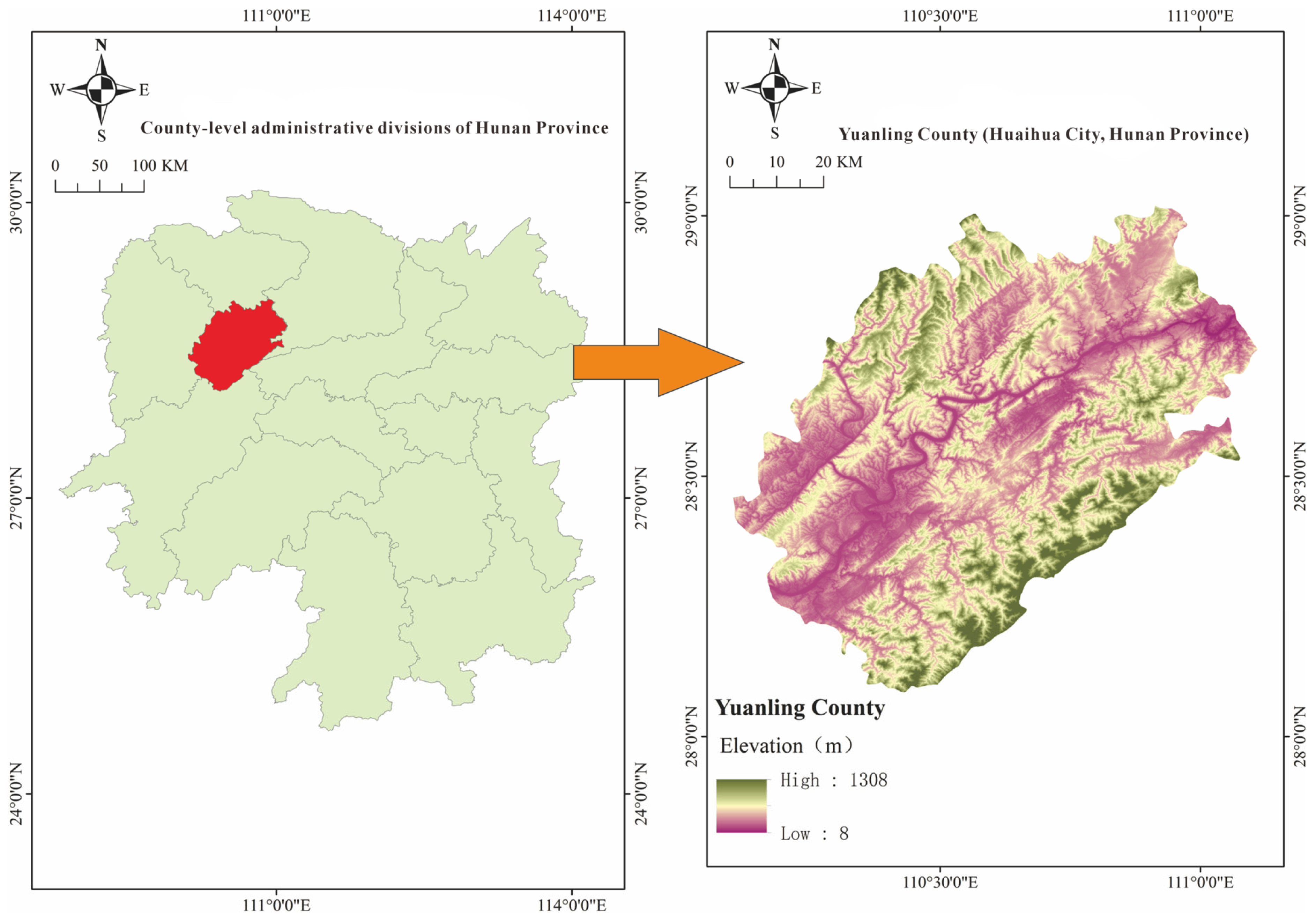
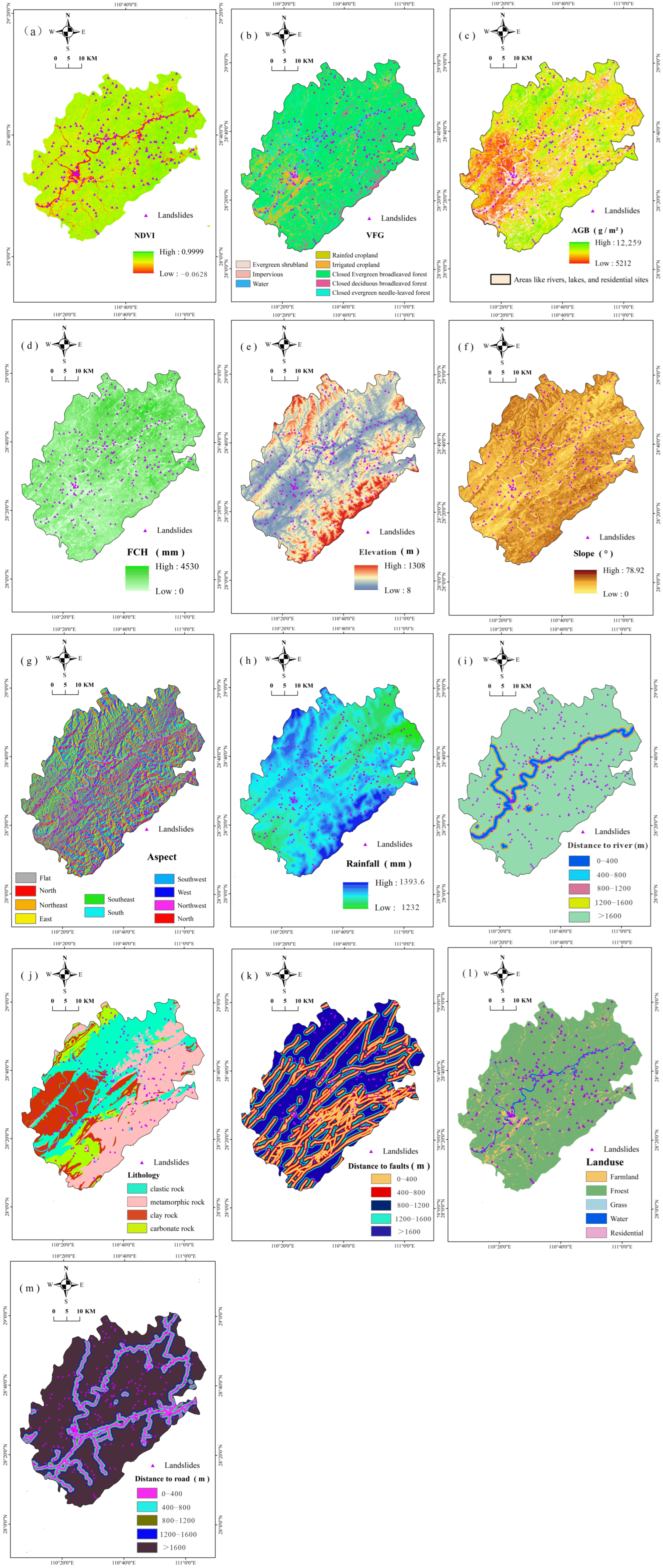

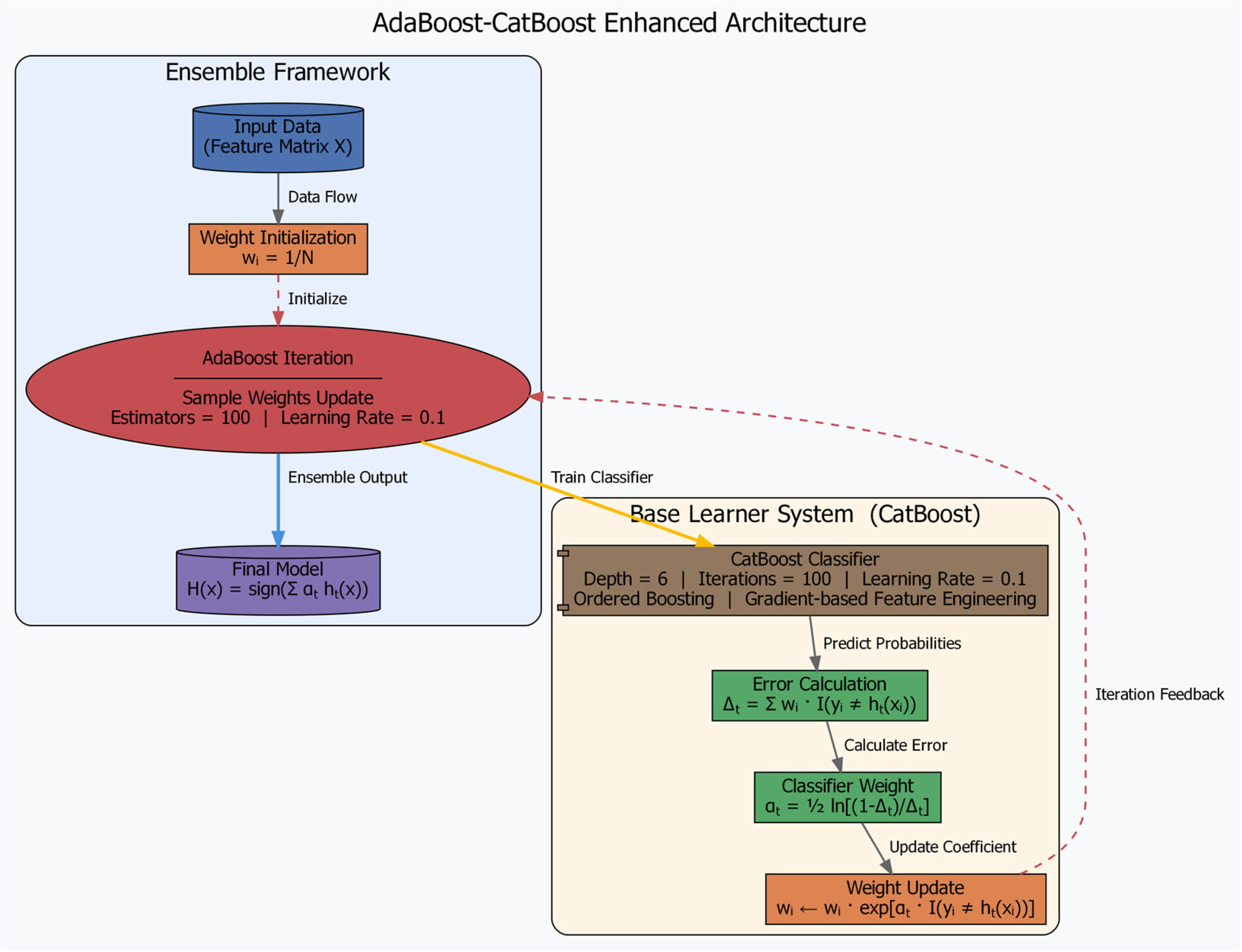
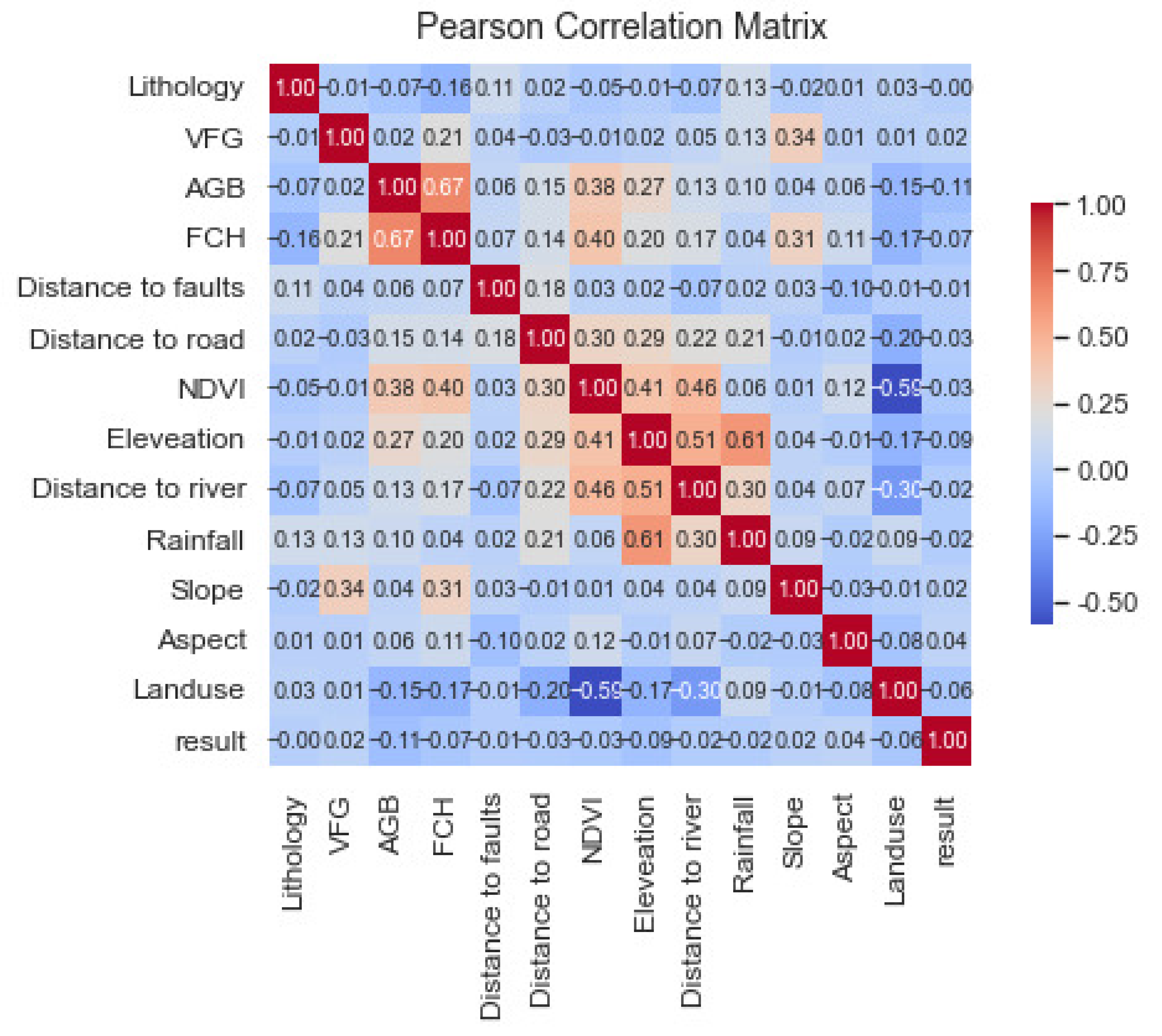
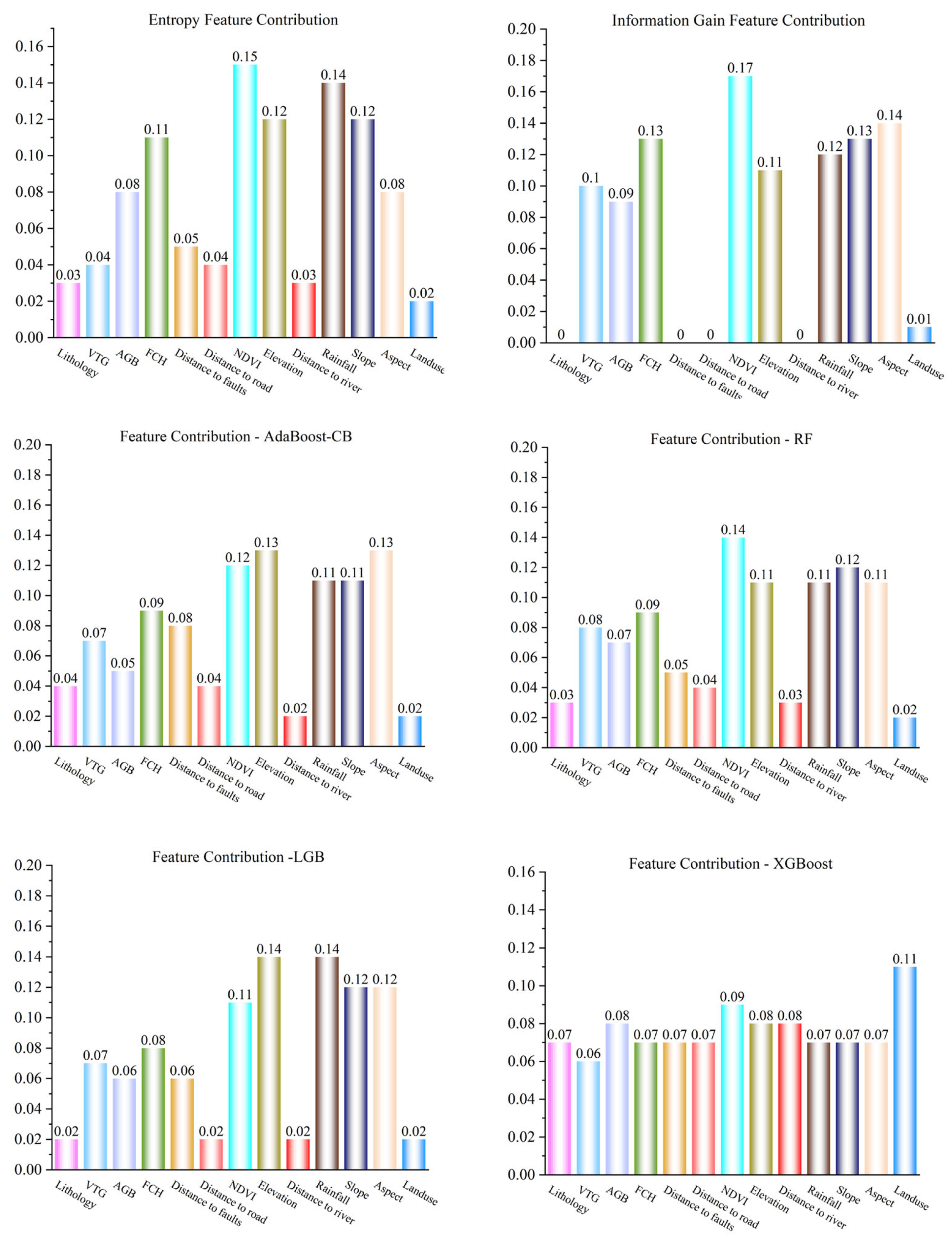
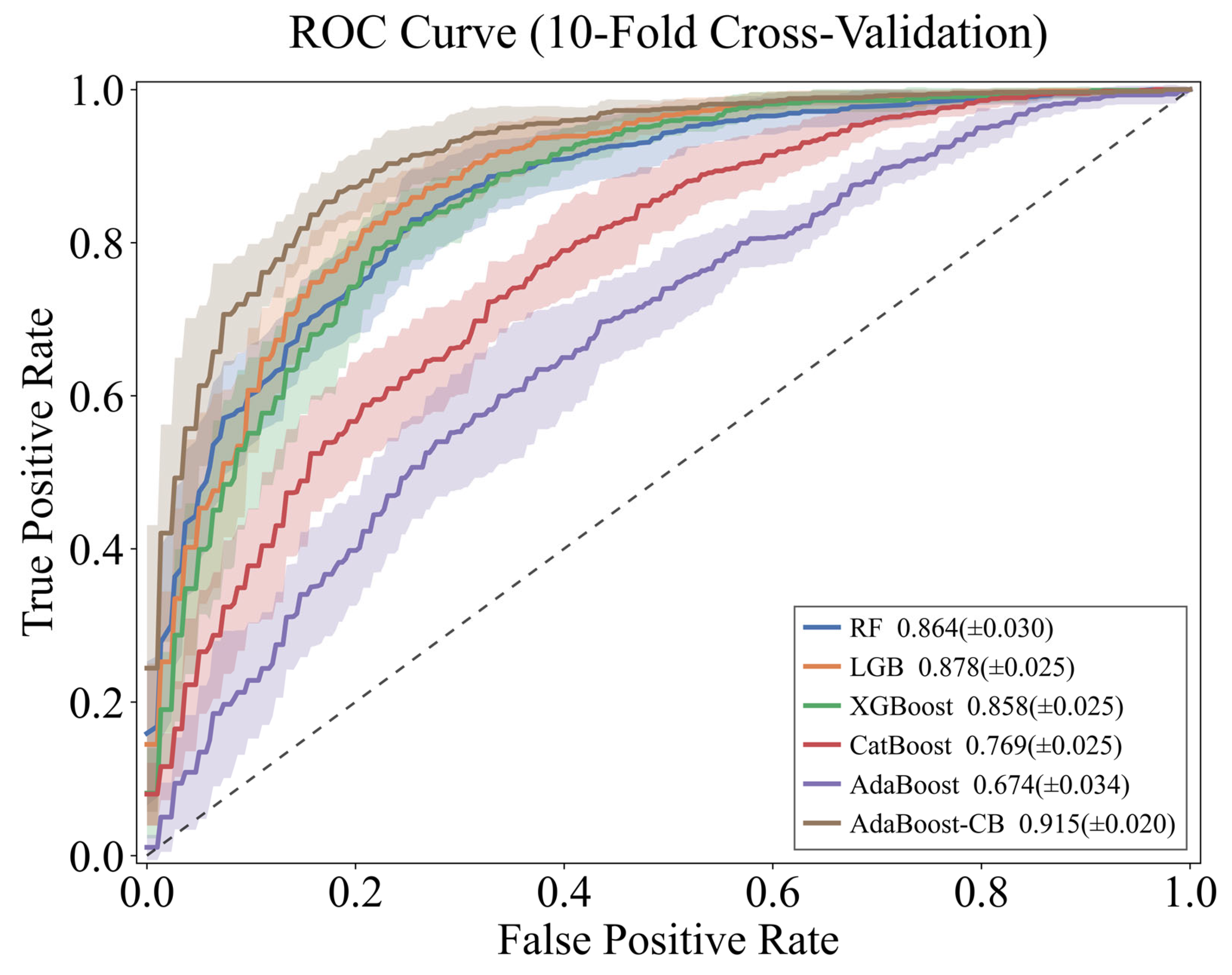

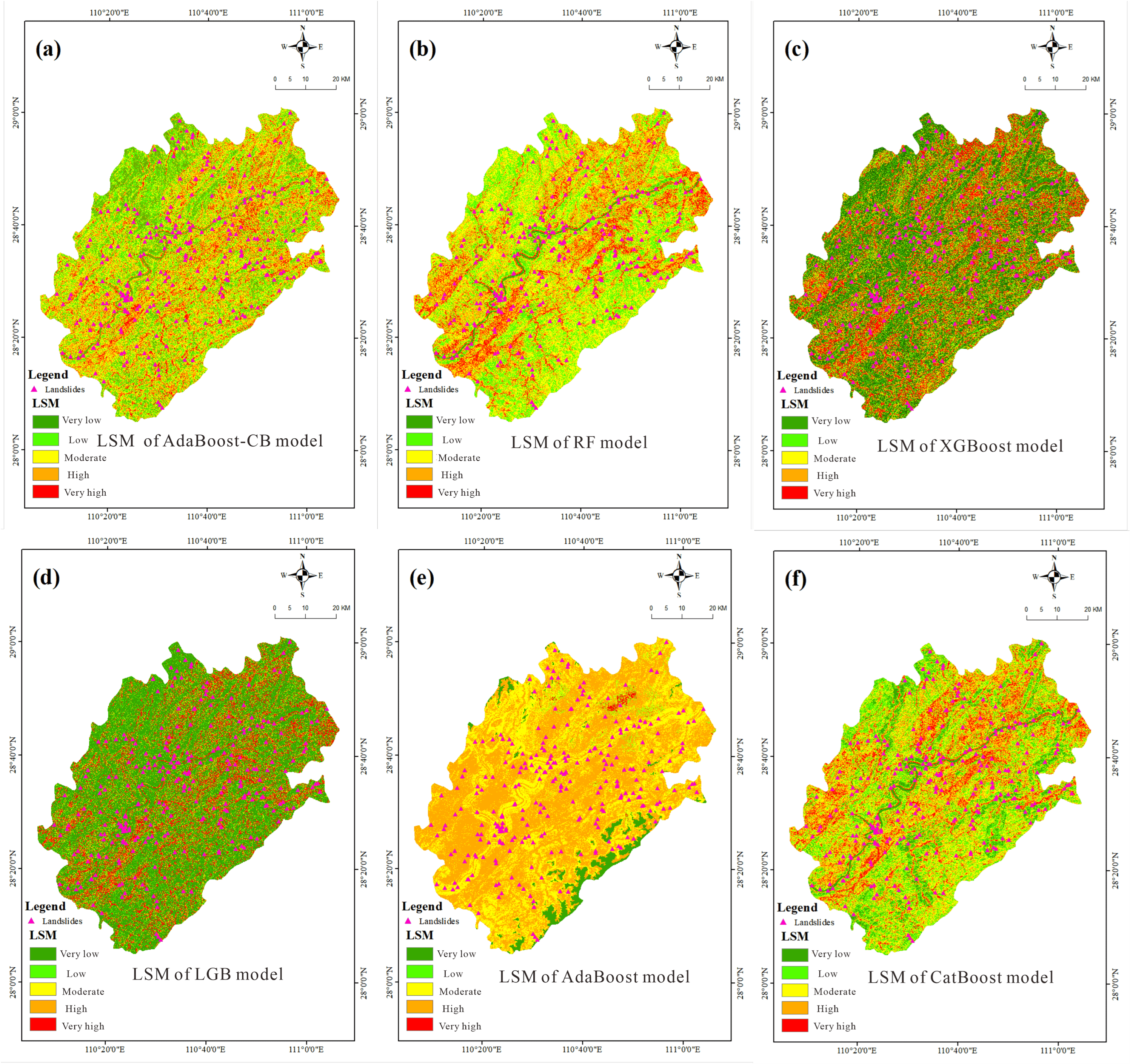
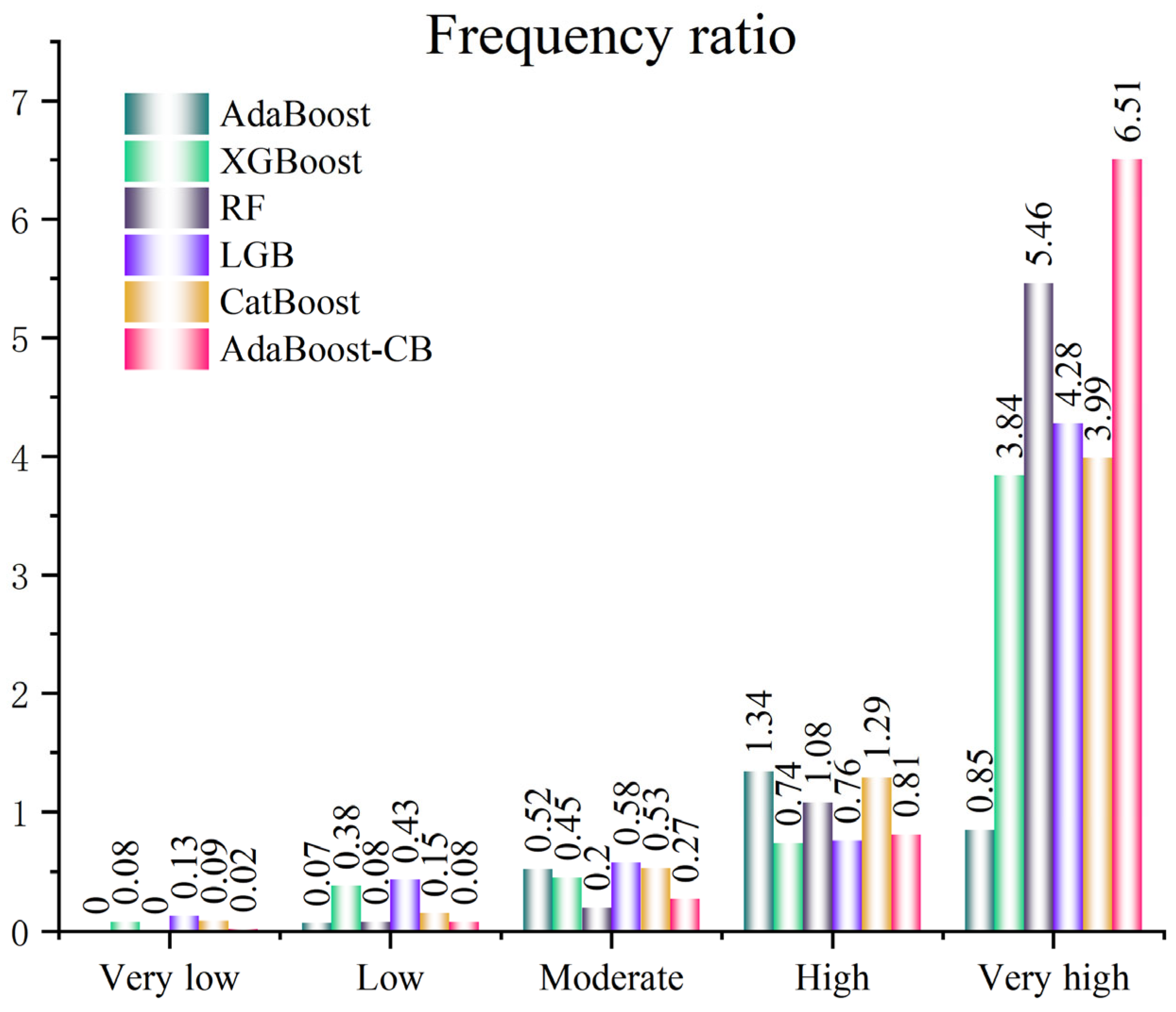

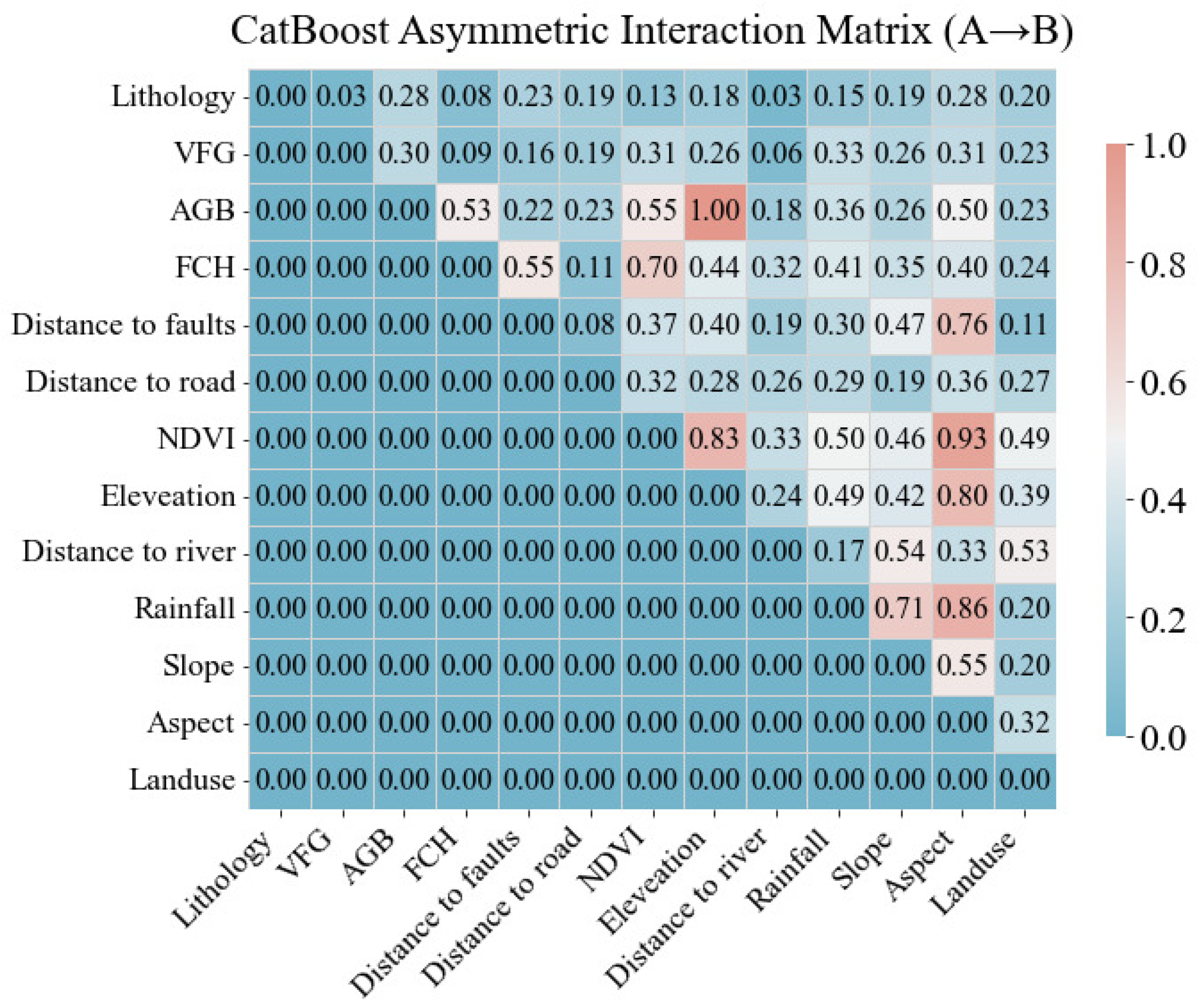
| ID | Factor Name (Unit) | Abbrev. | Native Resolution | Resampled Resolution | Data Source | Period/Year |
|---|---|---|---|---|---|---|
| 1 | Normalised Difference Vegetation Index (–) | NDVI | 30 m | 12.5 m | Chinese Ecosystem Research Network | 2019 |
| 2 | Vegetation Functional Group (–) | VFG | 30 m | 12.5 m | CASEarth | 2020 |
| 3 | Above-Ground Biomass (g/m2) | AGB | 30 m | 12.5 m | Digital Ecosystem Group, Institute of Botany, CAS. | 2019 |
| 4 | Forest Canopy Height (mm) | FCH | 30 m | 12.5 m | Digital Ecosystem Group, Institute of Botany, CAS. | 2019 |
| 5 | Elevation (m) | DEM | 12.5 m | 12.5 m | NASA ALOS 12.5 m DEM | 2006–2011 |
| 6 | Slope angle (°) | Slope | 12.5 m | 12.5 m | NASA ALOS 12.5 m DEM | 2006–2011 |
| 7 | Slope aspect (–) | Aspect | 12.5 m | 12.5 m | NASA ALOS 12.5 m DEM | 2006–2011 |
| 8 | Mean annual rainfall (mm) | Rain | 1 km | 12.5 m | Qinghai–Tibet Plateau Data Centre | 2018–2022 mean |
| 9 | Distance to river (m) | DistRiv | Shp | 12.5 m | OpenStreetMap (updated 2024) | 2024 |
| 10 | Distance to fault (m) | DistFau | 1:200,000-scale mapping | 12.5 m | 1:200 k geological map | 2022 |
| 11 | Lithology (–) | Litho | 1:200,000-scale mapping | 12.5 m | 1:200 k geological map | 2022 |
| 12 | Land-use type (–) | LU | 30 m | 12.5 m | Wuhan University dataset | 2021 |
| 13 | Distance to road (m) | DistRoad | Shp | 12.5 m | OpenStreetMap (updated 2024) | 2024 |
Disclaimer/Publisher’s Note: The statements, opinions and data contained in all publications are solely those of the individual author(s) and contributor(s) and not of MDPI and/or the editor(s). MDPI and/or the editor(s) disclaim responsibility for any injury to people or property resulting from any ideas, methods, instructions or products referred to in the content. |
© 2025 by the authors. Licensee MDPI, Basel, Switzerland. This article is an open access article distributed under the terms and conditions of the Creative Commons Attribution (CC BY) license (https://creativecommons.org/licenses/by/4.0/).
Share and Cite
Zhu, K.; Hu, S.; Kong, Y.; Zhou, J.; Teng, J.; Luo, W.; Li, J.; Pu, Y.; Su, T.; Zhao, J.; et al. Enhancing Sustainable Disaster Risk Management: Landslide Susceptibility Evaluation Using AdaBoost-CB Ensemble and Multi-Dimensional Vegetation Metrics in Yuanling County, China. Sustainability 2025, 17, 9358. https://doi.org/10.3390/su17219358
Zhu K, Hu S, Kong Y, Zhou J, Teng J, Luo W, Li J, Pu Y, Su T, Zhao J, et al. Enhancing Sustainable Disaster Risk Management: Landslide Susceptibility Evaluation Using AdaBoost-CB Ensemble and Multi-Dimensional Vegetation Metrics in Yuanling County, China. Sustainability. 2025; 17(21):9358. https://doi.org/10.3390/su17219358
Chicago/Turabian StyleZhu, Kangcheng, Sen Hu, Yuzhong Kong, Jianwei Zhou, Junzhe Teng, Weiyan Luo, Jihang Li, Yang Pu, Taijin Su, Junmeng Zhao, and et al. 2025. "Enhancing Sustainable Disaster Risk Management: Landslide Susceptibility Evaluation Using AdaBoost-CB Ensemble and Multi-Dimensional Vegetation Metrics in Yuanling County, China" Sustainability 17, no. 21: 9358. https://doi.org/10.3390/su17219358
APA StyleZhu, K., Hu, S., Kong, Y., Zhou, J., Teng, J., Luo, W., Li, J., Pu, Y., Su, T., Zhao, J., & Jiang, Z. (2025). Enhancing Sustainable Disaster Risk Management: Landslide Susceptibility Evaluation Using AdaBoost-CB Ensemble and Multi-Dimensional Vegetation Metrics in Yuanling County, China. Sustainability, 17(21), 9358. https://doi.org/10.3390/su17219358





